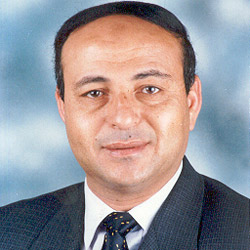No effort spared to ensure safety of priceless ancient statue
CAIRO: The transfer of the Ramses statue from its downtown residence is pending on one more test slated to take place this Thursday. Two specially made vehicles will carry a mock statue, of the same size and weight, from Tahrir to the Giza Plateau.
Last weekend, an initial test was carried out to check the path of the transportation process. The path was marked with chalk so that it can be retraced during the mock test this weekend and during the transportation of the actual statue on August 25. The first test started last Friday at midnight and ended at 5 a.m. on Saturday. The mock test is expected to take approximately the same time.
“The reason that we decided to move this statue is because of what’s happening to it, says Zahi Hawass, head of the Supreme Council of Antiquities.
The decision to move the statue of the Pharaonic king from Ramses Square has received heavy criticism. Critics expressed concerns over the necessity of the move and the safety of the process.
Hawass highlighted the sound and air pollution within the square housing the statue. Ibrahim Melhem, president of Arab Contractors, the company responsible for the transportation, explains that the tests they carried out on the statue revealed 12 types of polluting material accumulating over the surface of the statue, including dust, carbon, lead and oxides.
“But the most important element is the underground, says Hawass. The underground line running under the statue, he explains, is a source of constant vibrations that endanger the statue.
During a press conference held at the Supreme Council of Antiquities, Hawass repeatedly assured all that he would not have taken the decision to move the statue if there was a risk in the process. He adds that the statue will not be moved if there are safety concerns. The ongoing mock tests aim at uncovering any unforeseen risks.
Hawass says the committee responsible for the transportation has been studying all the details, regardless how small they are, since 2002. He says he is delighted that an Egyptian company, the Arab Contractors, is taking charge of the LE 6 million transportation project.
The statue is not insured against accident or damage; Hawass explains that he felt “there’s no need to. The ancient Egyptians moved the statue 3,000 years ago, he says, and in 1954, the statue was moved to its current location. In the 1954 move, the statue was dismantled into six pieces and then it was pieced together, with missing parts reconstructed and a three-meter-high base built to hold it.
In another departure from the precedent set in 1954, the statue will be moved vertically, not horizontally. Arab Contractors have designed two vehicles to carry the 11.5-meter high statue that weighs 83 tons.
The ongoing process started by strengthening the current statue base with external supporters and replacing the existing steel rods. The cage that will carry the statue will be erected on the external supports. A bridge holding the cage will be erected and the old base will be destroyed, shifting the weight of the cage and the statue onto the bridge. Using jacks of 400 ton capacity, the front and back ends of the bridge will be lowered onto the two vehicles.
The cage is designed to maintain the axis of the statue at 90 degrees throughout the transportation. Melhem explains that studies have shown that the statue should maintain its vertical structure with a 90 degree angle.
The statue will reach a temporary location at the Giza Plateau, where it will be restored. The restoration is expected to take six months to a year. When the construction of the nearby Grand Museum base is complete, the statue will be moved there.



